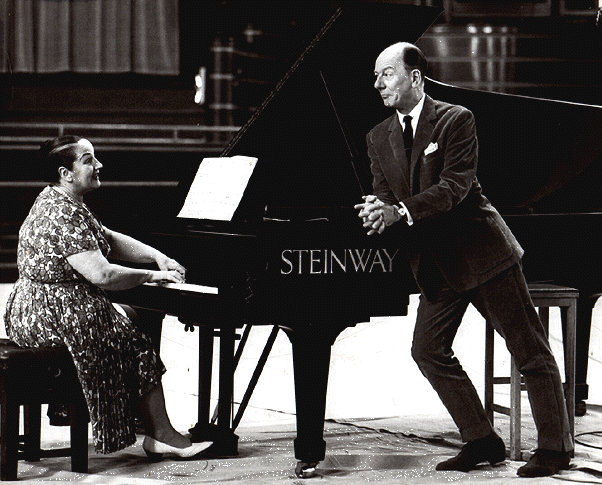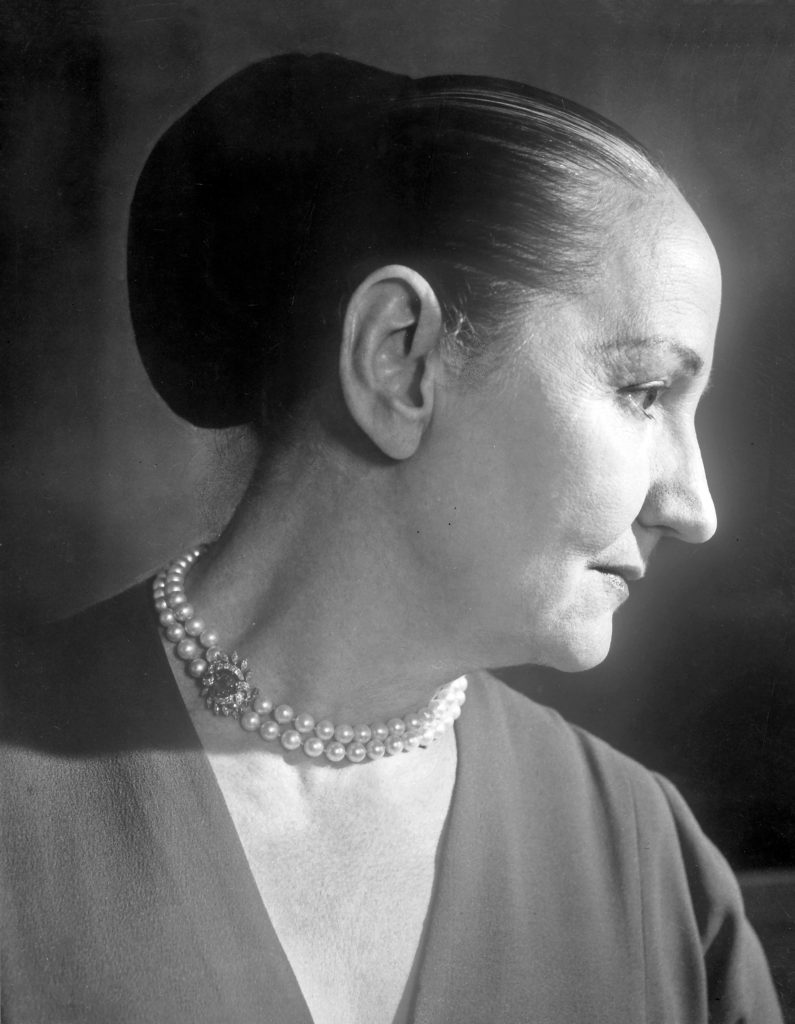Mark Ainley surveys the artistry of Greek pianist Gina Bachauer, to mark the release of her complete Mercury Living Presence recordings.

Many pianists are impossible to classify and fit no school. Gina Bachauer was one of these… unlike most modern pianists she was a romantic with a virtuoso approach to the keyboard…. She played in an unmannered, unaffected way, never placing effect above substance… Her death caused real sorrow in the musical world. Bachauer was not only a popular and respected international musician: she was also a beloved figure.
- Harold C. Schonberg, The Great Pianists
When Gina Bachauer made her American debut at New York’s Town Hall in October 1950, the local public had heard nothing about this pianist from Greece, and a mere thirty-five patrons were in attendance. Seated in the hall was one patron who knew her: Dimitri Mitropoulos, conductor of the New York Philharmonic, who had studied with the same teacher and conducted Bachauer’s concerto debut in Athens fifteen years earlier. Also in the audience were pianists Myra Hess and Simon Barere, as well as a budding New York Times columnist who would become a leading expert on great pianists, Harold C. Schonberg.
Despite a significant number of international appearances over the years, Bachauer was terrified – “the piano seemed two miles away when I walked on stage and I thought I would never reach it!” – but the event was a triumph, Schonberg declaring that the Bachauer had “put herself into the foremost ranks of pianists, male or female.” For the rest of her life and after her death, the fastidious writer remained a fervent admirer, year after year lauding her distinctive balance of technical command and impeccable musical intelligence.
This recital was the turning point of a career that had suffered multiple setbacks over the previous fifteen years. Bachauer was immediately booked for a US tour and her next New York recital in the same hall a mere three months later was sold out, and she went on to become a major international headliner for the next quarter century – The Queen of Pianists, as the legendary agent Sol Hurok would dub her. Although her sudden death at the age of sixty-six truncated a career that might have been decades longer, Bachauer’s name continues to inspire reverence.
Beginnings
She was born Luisa Dorothea Bachauer in Athens on May 21, 1910 (her year of birth was at various times given as 1911, 1912, and 1913) of Austrian parents whose lineages were German on her father’s side and Italian (of Czech and Russian extraction) on her mother’s. Her decisiveness was apparent at an early age: she declared as a teen that she would thereafter be called Gina, just as she had determined at the age of six that she would become a pianist. After attending a recital by Liszt’s pupil Emil von Sauer, the young girl kept repeating the phrase, “I want to learn to play the piano!” Her parents assumed that this desire would fade by the time she woke the next morning. It did not then, and it never did.
She learned some basics from a local teacher before studying with Ludwig von Wassenhoven, Dimitri Mitropoulos’s piano instructor, until his death in 1920. Bachauer then spent the next nine years at the Athens Conservatory with Woldemar Freeman, a Polish pianist who had studied alongside Rachmaninoff in Moscow and had also trained with the titanic Busoni. She was only enrolled part-time, as her apprehensive father insisted on more practical academic grounding; she therefore studied law for two years at Athens University while practicing piano into the night. Eventually her father relented and sent her to Paris to study with Alfred Cortot, who had extended the invitation after hearing her at the Conservatory in 1929.
Bachauer spent three years under Cortot’s tutelage at his illustrious École Normale de Musique and she is said to have received coaching by Rachmaninoff thanks to a letter of introduction from Freeman. Some members of Rachmaninoff’s family would later take issue with Bachauer’s account of her lessons, claiming that the composer-pianist only had one real student, Leonid Kreutzer; however, Rachmaninoff is known to have mentored several pianists in more informal circumstances, the most publicly recognized being Bachauer and Ruth Slenczynska.
Overcoming obstacles
Even with her world-class training and incredible talent, Bachauer’s career suffered numerous obstacles. She was a finalist in the 1933 Vienna International Music Competition (the same where Dinu Lipatti was edged from first place) but soon after, her father’s bankruptcy forced her to return to Athens. She began to assist the family financially by teaching twelve hours a day at the Conservatory, a role she had no choice but to continue after her 1935 Athens concerto debut with Mitropoulos did not successfully launch her career.
She had only just returned to the continent for a tour in 1939 when World War II broke out. Although many believed that the conflict would be over in a few weeks, Bachauer thought it wise to return home. When she accepted an invitation to play in Egypt, she never expected that she would be unable to leave for the next six years.
However, her time there was vitally important in many respects. When Bachauer was in Alexandria for a recital with her teacher in 1937, she met John Christodoulou, a cultured gentleman whose brother was married to Bachauer’s aunt. He had introduced the pianist to the cosmopolitan city’s elite social circles, and their relationship blossomed and they married.
Throughout the war years, Bachauer taught extensively while giving over 600 recitals for allied troops, a plane being put at her disposal so that she could give up to three performances a day. As always, the industrious pianist turned adversity into an opportunity: “I learned to play everything – jazz, boogie-woogie, light classics. I learned to shift my moods and play whatever the soldiers asked. And I played on all sorts of pianos – uprights, grands, in tune, out of tune. It was a very great experience.”
Postwar Success
As the war ended with the couple’s financial investments totally devalued, Bachauer was flown to London as a consultant for Gabriel Pascal’s film Caesar and Cleopatra with the hopes of launching her career in Europe. However,she was unable to secure a visa for that job, and the death of her manager in Paris left her with no connections in the local musical scene. She auditioned for conductor Alec Sherman, who promptly booked her to play the Grieg Concerto at Royal Albert Hall, and her luck turned: she was picked up by the prestigious agency Ibbs and Tillett in 1947 and signed to a record deal with HMV the next year.
But amidst these long-awaited successes, tragedy struck: Christodoulou suffered a fatal heart attack in early 1950, a devastating blow that Bachauer would avoid discussing in interviews. Then two years later her father died. For the rest of her life, she kept both of their photos in a locket that she would touch before each concert. Her relationship with her devoted musical partner Alec Sherman deepened and they married in November 1951, two weeks after a New York Philharmonic concert with Mitropoulos that was attended by President and First Lady Truman. Sherman would give up his career to manage his wife’s career, stating “there are many conductors but only one Gina Bachauer,” and for the next 25 years, the pianist toured internationally with a consistent level of success and critical acclaim that she had long sought.
Bachauer died suddenly of a heart attack prior to a scheduled appearance at the Athens Festival on August 22, 1976. After Antal Doráti conducted Beethoven’s Eroica Symphony at the outdoor concert near the Acropolis, Bachauer’s death was announced to the audience. The orchestra repeated a movement from the symphony as concertgoers filed out in silence.
A rich legacy
Bachauer was a living example of her assertion that music “is an art that demands that you give and give. It doesn’t take half measures, you must devote all your life.” Her own commitment was evident not just from her diligent practice regimen of seven hours a day (even during her 6-week annual holiday) and gruelling schedule of over 100 concerts a year, but also by the unwavering generosity she offered arts organizations, colleagues, and young musicians.
She was a founding performer of the John F. Kennedy Center for the Performing Arts and an associate of the Jerusalem Music Centre; she regularly played at benefit concerts for causes ranging from Greek orphans to Jewish charities; she helped connect talented colleagues with management and booking opportunities both in Europe and abroad; and she mentored promising young artists. If her schedule prevented her from personally providing the instruction she believed aspiring musicians required, she arranged for their tutelage to be overseen by respected colleagues (like Ilona Kabos in London) and continued to track their progress.
Her kinship with the Utah Symphony Orchestra and their director Maurice Abravanel (who called her “Saint Gina”) was particularly significant: it was Bachauer who got the orchestra booked for the Athens Festival as part of their first international tour in 1966, and her boundless support has never been forgotten by the local musical community. The orchestra’s hometown of Salt Lake City is headquarters to the Gina Bachauer International Piano Foundation (founded the year she died), which operates the prestigious Gina Bachauer International Piano Competition, and the state’s Brigham Young University houses the Bachauer Archive, which safeguards an abundance of materials donated by the pianist’s widower Alec Sherman.

Bachauer’s artistry
While the name Gina Bachauer is today most often mentioned in the context of the illustrious competition, the pianist’s recordings provide a direct experience of the artistry that secured her international reputation. Some of the enduring appeal of her music-making may lie in how her craft was an authentic expression of her innate being. “You can hear who she was when her hands touch the piano,” says British pianist Norma Fisher of her mentor. She was assertive yet poised, impeccably gracious and generous, radiating affection with a focused but caring gaze. Her playing was notable for an uncompromising directness and clarity that always exuded warmth, a purity of sound that was robust at all dynamic levels, each phrase skillfully shaped and impeccably balanced. Her pianism, like the great lady herself, had a combination of naturalness and cultivation that continues to enthral.
Bachauer had an incredibly broad repertoire that spanned from Bach and Scarlatti to Bliss and Stravinsky, though it was not as expansive as she herself would have liked: as a child, she cried when she realized that she would never have the time required to properly learn all the music she loved. Her means of learning new works was both unconventional and meticulous: she would explore each score away from the piano – often in bed, in order to better focus her mind – for some fifteen or twenty days before playing a note of the piece. “After having studied this way… I then go to the piano and feel that I am prepared to practice at the instrument.” Once she had assimilated both the musical content and technical demands of the work, she would let it sit for months so that “beautiful things you never saw or heard before begin to appear.” (Another legendary pianist had the same unorthodox process: Dinu Lipatti.)
If Bachauer didn’t record as extensively as many of her colleagues, her output is not insignificant and her accounts are magnificent, even if like many other great musicians she preferred the dynamic relationship of live performance to the more secluded studio. “I personally need my audience. I cannot just sit there and play. I want them to be with me and I want them to be near me.” She always sought to evolve the details of her interpretations and therefore like some of her colleagues thought that “when we hear our recordings after some years, we may want to open the window and throw ourselves out.”
The Mercury Recordings
Whatever reservations Bachauer might have had about the longstanding value of recording, her discography continues to be admired by music lovers and critics the world over for the pianist’s unique blend of musical intelligence and technical brilliance. Her venerated Mercury ‘Living Presence’ discs were set down in New York and London between 1962 and 1964, after she had produced about a dozen albums for HMV between 1949 and 1959 and prior to a final 1973 LP for Erato. While it would have been a full-time job to secure Bachauer’s enormous repertoire on disc, these lionized Mercury recordings – as admirable for their remarkable sound quality as for the pianist’s captivating interpretations – preserve for posterity some of the solo and concerted works for which she was most celebrated in the concert hall.
Bachauer’s heroic performance of Beethoven’s Emperor Concerto showcases her full-bodied pianism, though Robert C Marsh’s High Fidelity review began with the rather dated assertion that “it is rare for a woman pianist to record this work.” He did, however, acknowledge that her playing made one “forget about the supposed limitations of the weaker sex” (somewhat backhanded praise with that archaic expression) and he commended the reading as “full scale with the kind of strong, secure projection that marks an exceptional artist.” The UK’s Gramophone was less equivocal in their review, finding Bachauer’s account “really outstanding, both technically and interpretatively,” and concluding that “it is this sheer character of the performance that lifts it right out of run-of-the-mill records of this concerto.”
Esteemed critic Harris Goldsmith in High Fidelity lauded Bachauer’s Brahms B-Flat Major Concerto as one of the finest he’d ever heard (another being Myra Hess in concert in New York), noting that the Greek artist surmounted the composer’s own proclamation that the work was “not for little girls” because she herself was more of an Amazon. While Goldsmith observed that Bachauer could at times be “reckless,” he nevertheless found this traversal to be “a performance of immense assurance and propulsive vitality” and that “the musical conception is grandly sonorous, with both drama and response in abundance when those qualities are called for.” He made special mention that the “uncommonly fine orchestral support” of Stanislaw Skrowaczewski and the London Symphony Orchestra added extra allure to this “sober, mature interpretation.”
Goldsmith was less enamoured with the Chopin F Minor Concerto Op.21 and Fantasy in F Minor Op.49, observing that Bachauer played “efficiently” but lacked flexibility in the Concerto while calling her Fantasy a “sturdy, monolithic performance.” If her rhythm is at times a bit less fluid than one might desire, present-day listeners will surely still admire these vigorous, red-blooded accounts – as well as her E Minor Concerto Op.11 – for their vivaciousness, beautiful nuancing, and exquisite colours.
Marsh’s High Fidelity review of Bachauer’s Beethoven’s G Major Concerto was similarly framed as his take of her Emperor: “a lady’s interpretation of the score” which itself he claimed musicians called “the ladies’ concerto.” He nevertheless observed that “the surface polish is very high, the technique is hardly to be faulted, the runs are silken, and every note shines as if it had a little Italian light bulb inside.” If he found elements of her reading lacking, he was more laudatory in his assessment of the Sonata No.9 in E Major Op.14 No.1, finding it preferable to Richter’s issued Carnegie Hall account and noting that the only real competition came from the great Walter Gieseking.
Bachauer’s solo album entitled “Queen of the Keyboard” (no doubt inspired by Sol Hurok’s marketing) features warhorses like Chopin’s A-Flat Major Polonaise Op.53 and Liszt’s Rhapsody No.12 alongside two of the piano repertoire’s most demanding works, the Brahms Paganini Variations (2nd book) and Stravinsky Three Movements from Petrouchka. It seems that the latter was the result of several complete takes made in a strenuous session, and when the delighted Mercury director Harold Lawrence exclaimed, “Gina, you are marvellous!” Bachauer shot back, “I am dead. Let us get on with this catastrophe!” The self-critical artist need not have worried: her playing is beyond reproach in all respects, Raymond Ericson in the New York Times noting that “the music streaks out from Miss Bachauer’s fingers with a speed and ease that is hard to believe” and recommending the album to “anyone who enjoys the legitimate and musical display of a prodigious keyboard technique,” while Goldsmith in High Fidelity was won over by the “forthright energy of her pianism.”
French impressionist music was an ideal vehicle for Bachauer’s commanding dexterity and refined effects, her Debussy exhibiting what William Flanagan in HiFi Stereo Review termed “extravagant mystery and ravishing colouring.” The pinnacle of her Mercury discs may be her account of Gaspard de la Nuit, with the legendary actor John Gielgud reciting the poems by Aloysius Bertrand that had inspired the three works in Ravel’s masterpiece. The suite was a mainstay in the pianist’s repertoire, singled out by Schonberg at Bachauer’s New York debut as “the outstanding achievement of an evening on an altogether Alpine level.” Flanagan praised this Mercury recording for its “fine sense of the work’s big line” in what he called “an impressively personal reading,” while High Fidelity’s review observed that Bachauer’s “control over keyboard colour and rhythmic outline is truly remarkable.”
An enduring presence
Gina Bachauer’s legacy continues to evoke respect, her steadfast devotion to her profession continuing to elicit the same from others. Schonberg articulated to perfection the towering artist’s everlasting position in the pianistic pantheon when he wrote, “Governments rise and fall, and the seasons change, but Miss Bachauer’s playing remains a constant. She represents the romantic tradition in piano playing – with her enormous technique, her big and penetrating tone, her love for the piano as a steed upon which to ride…Gina Bachauer continues to be one of the great pianists.” Her esteemed Mercury recordings allow her cultivated artistry to continue to inspire music lovers of all generations.



